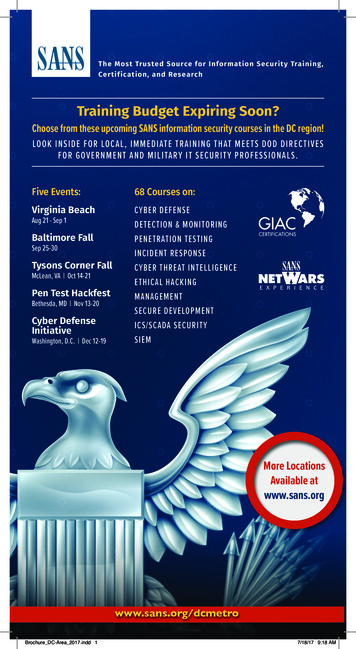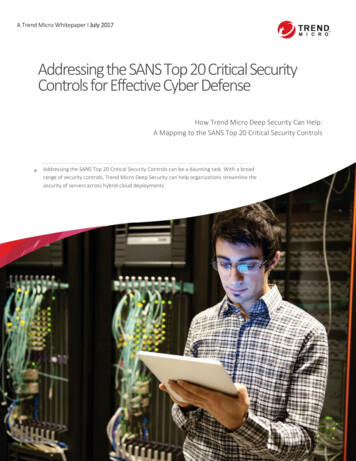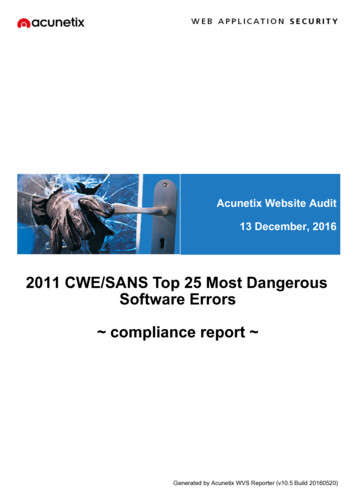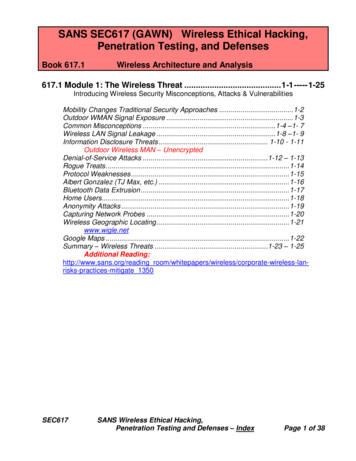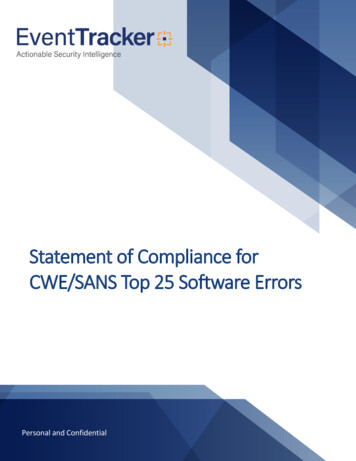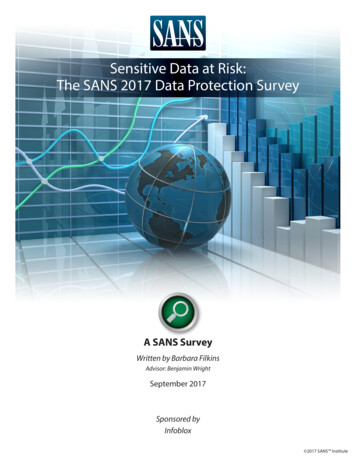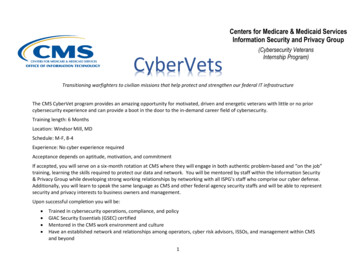
Transcription
#CTISummitProgram Guide@sansforensics#CTISummit
Welcome to the 5th annual Cyber Threat Intelligence Summit! Our AdvisoryBoard has been hard at work for months to make this the most engagingCTI Summit yet, and we’re delighted that you’re here to share this event withus. Five years in, this Summit is more relevant than ever, and we’ve carefullycurated the presentations and talks to provide experience-based, actionableRick Hollandstrategies you can use to win the battle against ever-stronger adversaries.It is a rare treat to have Cliff Stoll as our opening keynote speaker. It would not be an exaggerationto say that most of us owe our careers to his tireless efforts to track a hacker three decades ago,back when the FBI laughed at the notion of “computer crimes” being worth their time. To Cliff,it was an intellectual exercise and a matter of stubbornness, but over the course of his cat-andmouse game, he laid the foundation for what all of us do every day. His high-energy brand ofquirkiness, his persistent genius, and his rich perspective on our field promise to both entertain andinspire you.Lastly, remember that your participation is what makes this Summit truly one-of-a kind, andattendees tell us time and again that the greatest value of our Summit is the plethora of newlyforged or deepened industry connections they make during their time with us. I can tell you thatover the past five years, I have built some great personal and professional relationships at thisSummit. Take advantage of having a couple hundred of the sharpest minds in the threat intelligencecommunity here with you for the next two days. Introduce yourself to those sitting around you,engage with our expert speakers during networking events, ask questions during Q&A sessions,and weigh in on twitter #CTISummit and @DFIRSummit. Join the Summit Advisory Board tonightat our “The Spy Who came in from the Cold” networking event to hear the board share insightsinto threat intel trends, tradecraft tips, and advice for contributing your expert knowledge at afuture SANS Summit.Let’s get this party started!Sincerely,Rick HollandCyber Threat Intelligence Summit Co-Chair
AgendaAll Summit Sessions will be held in Salon 4 (unless noted).All approved presentations will be available online following the Summit mitsAn e-mail will be sent out as soon as the presentations are posted, typically within 5 business days of the event.Tuesday, January 318:00-8:45amRegistration & Networking Breakfast8:45-9:00amWelcome & Introductions9:00-10:00am(Still) Stalking the Wily Hacker:Three Decades of Computer Security in Perspective(LOCATION: SUMMIT FOYER)Before anyone thought to utter the words “cyber threat intelligence,” Cliff Stoll was doing it(and chronicling it in the seminal book that led many of us to careers in the field). From hisvantage point as the father of the discipline, he’ll share his unique view of how far we’ve come(hint: he’s impressed) and take a realistic look at what the future holds. He’ll examine someemerging threat vectors we need to be paying attention to, and offer some words of wisdom tocyber threat intel newcomers and do-it-yourselfers.Clifford Stoll, Author, The Cuckoo’s Egg: Tracking a Spy Through the Maze of Computer Espionage10:00-10:30amNetworking Break & Vendor Expo10:30-11:05amThrowback Threat Intel:How Old-School Intel Techniques Will Take Us Into the Future(LOCATION: SUMMIT FOYER)As we convene for the 5th annual SANS CTI Summit, everything old is new again. We’redigging into classic, time-tested tradecraft and applying it in innovative ways to cyber threat intel.We’ll look at how cyber threat intel has evolved in the years since the first CTI Summit, giveourselves a collective pat on the back as an industry for the progress we’ve made, and thenget real about how much work we still have to do. We’ll look at how borrowing from relateddisciplines has helped us evolve, anticipate where our threats may take us over the next fiveyears, and note how tried-and-true tradecraft will continue to be just as important as all theshiny new tools – if not more so.Mike Cloppert, Rick Holland, & Robert M. Lee, CTI Summit Co-Chairs11:05-11:40pmInglorious Threat IntelligenceFrom the depths of the Atlantic Ocean to the deserts of North Africa to the formation of theOffice of Strategic Services, World War II provides countless lessons for the intelligence analyst.The talk will discuss the evolution of intelligence work at that time and how it had to evolve toaddress the needs of the intelligence consumer. Rick will draw conclusions from the intelligencesuccesses and failures of the conflict that you can apply to your threat intelligence program.Rick Holland (@rickhholland), Summit Co-Chair, SANS Institute@sansforensics#CTISummit
Tuesday, January 3111:40am-12:15pm Integrating Cyber Threat Intelligence Using Classic Intel TechniquesService providers frequently limit the scope of CTI to the dissemination of threat feeds, thirdparty analysis, and indicators. As the cyber industry moves away from this limited understandingand begins to more clearly define CTI as a full-spectrum endeavor spanning tactical, operational,and strategic threat intelligence areas, it is important to illustrate how organizations caneffectively incorporate actual CTI into their business models. Through integration of theintelligence cycle into the cyber domain and appropriate tradecraft, Noblis will discuss howother organizations can incorporate this model. As a result of this presentation, the audiencewill learn how to incorporate classic intelligence techniques into their cyber threat model toprovide analysts and decision makers with actionable, predictive intelligence, and improvedsituational awareness. In addition, audience members will learn how integrating both tools andpeople (net defenders and cyber all-source analysts) within their CTI model is imperative tocreating a holistic cyber-threat picture. To achieve this, we will use case studies to challenge thenotion that effective CTI is purely technical – it is not. Effective CTI is the marriage between netdefense and all-source analysis.Elias Fox, Cyber Threat Intelligence Analyst- R&D, Noblis-NSPMichael Norkus, Cyber Threat Intelligence Analyst- R&D, Noblis-NSP12:15-1:30pmNetworking Lunch - Vendor Expo1:30-2:05pmThe Threat Intel Victory Garden: Creating, Capturing, and Using Your OwnThreat Intelligence Using Open Source Tools(LOCATION: SUMMIT FOYER)Many threat intel programs ignore the most valuable source of intelligence: their ownenvironment. In the battle to secure your organization, the benefits of “growing your own”threat intelligence are many. Self-sourced threat intel is quite possibly the most relevant originof indicators when detecting and investigating actionable threats faced by your organization.Home-grown threat intel is also easy to prioritize and enrich because much of the originalcontext is available. Unfortunately, many threat intelligence programs are hampered by manualprocesses and procedures. In this talk we will briefly discuss some common internal sources ofthreat intelligence, then present some novel collection techniques including open source toolslike the stoQ framework and open source honeypot solutions. We will show through recordeddemonstrations how indicators from these sources can be sourced, centrally stored, managed,and leveraged in an automated method. Pointers to usable code/resources that attendees cantake advantage of immediately will be provided.Dave Herrald (@daveherrald), Security Architect, SplunkRyan Kovar (@meansec), Staff Security Strategist, Splunk@sansforensics#CTISummit
Tuesday, January 312:05-2:40pmLocation-Specific Cyber Risk: Where You are Affects How Badly You’ll be HackedMany wrongly think that because the internet is global, cyber threats are the same no matterwhere you are in the world. This line of thinking discounts the close-access, insider, and supplychain threat differences that exist when you change locations.Additionally, threat actors know and believe that travelers are less protected targets thanpeople in their homes. By compromising a business traveler overseas, it can provide an accesspoint into the corporate network. To prevent and mitigate these scenarios, organizations mustunderstand the location-specific threats to their information security. Organizations can do thisby understanding the operational environment and the threat actors that operate in the regionor country.The threat actors include host nation governments that are monitoring in-countrycommunications, APT-style groups, cyber-criminal groups, or hacktivists. Intelligence analystsevaluate the threat actors’ intentions and capabilities to determine a threat rating. With thisinformation, an analyst can then create viable risk scenarios through which their organizationcould experience information loss, operational disruption, or reputational damage. By measuringthe likelihood and impact of each scenario, the analyst can determine the overall cyber risk ofthat location. This information informs precise decision-making to take appropriate preventiveand mitigating measures.By measuring the location-specific cyber risk and thoroughly assessing the threats in a country,intelligence analysts can identify intelligence gaps, focus collection efforts, and lay the foundationfor multiple follow-on intelligence opportunities.Lincoln Kaffenberger (@LincolnKberger) Information Technology Officer, IMFJohn Kupcinski, Director, KPMG2:40-3:10amNetworking Break & Vendor Expo3:10-3:45pmUsing CTI to Profile and Defend Against theWorld’s Most Successful Email Scam(LOCATION: SUMMIT FOYER)In this talk, we will examine the various aspects of one of the world’s most successful emailcampaigns: The Business Email Scam. This campaign has stole nearly 3.1 billion over the pastthree years, and shows no signs of slowing down. This presentation will present researchspanning over three years across the globe, involving multiple case studies and banks fromNorth Carolina to Hong Kong. We will start by examining characteristics of the tools, context,and domains used by the attackers to trick companies. Using publicly-available tools, we willprofile just how large this campaign is, what evidence is available, and how to extract valuableindicators from the data. The presentation will conclude with lessons on how the audiencecan use aforementioned publicly-accessible, free tools to build profiles on attacks such as thisscam. We will discuss how to take seemingly arbitrary indicators and use them to protect ournetworks and business. Lastly, we will also briefly discuss open source tools that smaller teamscan use to maintain and organize their indicators.Matt Bromiley (@mbromileyDFIR), Senior Managing Consultant, Kroll@sansforensics#CTISummit
Tuesday, January 313:45-4:20pmReversing Threat Intelligence: Fun with Strings in MalwareOver the years, there have been huge hacks, many of which end up in the headlines. OPMhacked, Target hacked, and insert random company hacked. While it’s easy to get caught upin the vast scope of these attacks, we have to remember that it’s just a human on the other endpushing the buttons. In this presentation, we will look at malware samples from the dark web,identify places where the attackers slipped up, and use intelligence to find other related samples.Ronnie Tokazowski (@iHeartMalware), Senior Malware Analyst, FlashPoint4:20-4:55pmHunting Cyber Threat Actors with TLS CertificatesThis presentation will go over how net defenders and threat intel analysts can use TLS/SSL datafrom open source sites like scans.io and censys.io to defend their networks and track threatactors that use TLS/SSL to encrypt their command and control, perform credential harvestingor even manage their command and control infrastructure.Most analysts know and use Whois registrant info to track domains threat actors create.However, a lot of threat actors have learned to use Domain Privacy Registration which mitigatesthat tracking ability. Analysts also like to use passive DNS sources to track domains and ip’sas actors move their infrastructure. Others analysts use things like VirusTotal to track threatactors based off their malware but not everyone has access to VirusTotal. Using this techniquethat I will be discussing, defenders and analysts can easily track malware command and controlinfrastructure as it moves and put the appropriate defense mitigations in place as needed.Mark Parsons, DevOps/ThreatIntel, Punch Cyber Analytics4:55-5:00pmDay 1 Wrap-Up5:00-6:00pmNetworking Reception & Vendor Expo6:00-7:30pmNETWORKING RECEPTION: The Spy Who Came in from the Cold(LOCATION: SUMMIT FOYER)(LOCATION: SALON 5, 6, & 7)We’re getting cozy with the Summit advisory board in the CTI Ski Chalet. Cuddle up with acup of cocoa and some gooey s’mores, de-brief day 1 of the Summit with other attendees,and hear the board share insights into cyber threat intel trends, tradecraft tips, and advice onhow to get your expertise on the program at a future SANS Summit.Thank you for attending the SANS Summit.Please remember to complete your evaluations for today.You may leave completed surveys at your seator turn them in to the SANS registration desk.@sansforensics#CTISummit
Wednesday, February 18:00-9:00amRegistration & Networking Breakfast9:00-9:15amDay 2 Welcome & Overview9:15-10:00amKnowing When to Consume Intelligence and When to Generate It(LOCATION: SUMMIT FOYER)In the threat intelligence community there are consumers and there are generators. Manyorganizations only know that they want “threat intel.” However, the difference betweenconsuming and generating intel is vast and will structure intelligence requirements, goals, andmeasurements of success completely differently. In this presentation, the differences betweenthreat intelligence generation and threat intelligence consumption will be covered as well ashow to determine when your organization is ready for one or both. Additionally, intelligencerequirements will be covered to help ensure that your program is on track regardless of yourchoice. Many organizations should consume intelligence, some organizations should generateintelligence, and all organizations should know the difference.Robert M. Lee (@RobertMLee), CEO & Founder, Dragos, Inc.10:00-10:30amNetworking Break & Vendor Expo10:30-11:05amPen-To-Paper and The Finished Report:The (Often Overlooked) Key To Generating Threat Intelligence(LOCATION: SUMMIT FOYER)Generating meaningful intelligence is a challenge, even with the right people and technology.Analysts maintain extensive personal “databases” of notes and indicators, but typically do notmemorialize their insights in a finished form. The result is that intelligence—our knowledgeof threats, and the TI team’s core value proposition within the security organization—fallsinto a state of limbo. Indicators may make it to the SIEM, but incident responders and otherstakeholders still lack a complete, coherent picture of the threats they face. To realize the fullvalue of threat intelligence, organizations must embrace and institutionalize a process of creatingthe quintessential intelligence product: the finished report. Classic intelligence approacheschampion the finished report and—if it is correctly executed—praise its value. This talk willargue that the finished report is the only way to truly codify knowledge in way that benefitsboth tactical and strategic customers. This talk will explore decades-worth of US intelligencecommunity (IC) best practices for generating finished reports and adapt them to threatintelligence. Attendees will gain a new perspective on the importance of writing (and writingwell!), and they will learn simple approaches that they can immediately apply in their day-to-dayoperations to put their intelligence in a finished form.Christian Paredes (@cyint dude), Threat Intelligence Analyst, Booz Allen Hamilton@sansforensics#CTISummit
Wednesday, February 111:05-11:40pmThe Use of Conventional Intelligence Analysis Methodologies inCyber Threat IntelligenceWe need to stop re-inventing the wheel. Intelligence collection, analysis and disseminationmethodologies have existed for hundreds, in-fact thousands of years. Designed, honed andperfected by some brilliant analysts and operators, the cyber intelligence industry needs toembrace conventional analysis methodologies to better understand and predict the threatlandscape in which they operate. Predominately focused on methods used by British andUS agencies and Militaries the talk looks to identify various methods used to help betterunderstand the intelligence picture. From back-casting to cones of plausibility; from analysis ofcompeting hypothesis to breaking the mirror, there are methods that exist to better help usunderstand what happened, what is happening and what is likely to happen.Rob Dartnall, Director of Cyber Intelligence, Security Alliance Ltd.11:40am-12:15pm Wave Your False Flags!Deception Tactics Muddying Attribution in Targeted AttacksSo, you’re a threat intel shop? You want to have the beat on that ‘sophisticated’ group attackingyour clients? Good luck with that. The days of lifting a couple of relevant IOCs, googling around,and writing a fancy report with solid attribution are long gone. Today’s APT actors are wellaware of compilation timestamps and command-and-control infrastructure reuse and some ofthem value nothing more than to lead researchers astray. Investigators have had an increasinglydifficult time finding reliable and agreed upon metrics for attributing attacks. Recent debatesover the accuracy and usefulness of attribution keep touching upon the possibility that attackersmay be manipulating indicators. Rather than continue to discuss the ‘theoretical’ possibility offalse flags, we will present never before revealed, real-world examples of these operations. APTgroups have in fact been following published research and are using the information they gleanto throw researchers off their trail. The final aim is to discuss the relevancy of attribution in thecommercial and government sectors and to insist on curbing the appeal of ‘sexy attributionclaims’ in the threat intelligence space in favor of actionable intelligence.Brian Bartholomew (@Mao Ware), Senior Security Researcher, Kaspersky Lab – GreATJuan Andrés Guerrero-Saade (@juanandres gs), Senior Security Researcher, Kaspersky Lab – GreAT12:15-1:30pmLunch & LearnsSponsor: DomainToolsSponsor: FlashpointSponsor: AnomaliEnrich All the Things:Turning Threat Data intoThreat IntelligenceOver the Endpoint Horizon: EvolvingNetwork-centric Cyber Threat IntelligenceInto Enterprise Applied Business RiskIntelligence (BRI)Looking Beyond Your 4 Walls: PeripheryThreat intelligenceIn this session, you’ll get anoverview of how to take indicatorsfrom your network, includingdomain names and IP addresses,and connect them with nearlyevery domain on the internet.These connections help you profilethreat actors for the preventionof phishing, data exfiltration, andbrand compromise.Presenter: Mark Kendrick, Director ofBusiness Development, DomainToolsIn order to provide comprehensive risk assessments andknowledgeable security advice to business decision makers,we must move beyond classic network and endpoint threatintelligence. Current operating and application models of cyberthreat intelligence does not fully provide the elevated vantagepoints to reveal enterprise-wide risks. Mapping threats to criticalbusiness functions and assets can only be done by drawing onintelligence curated from multiple sources and applied to revealthe whole threat picture, beyond just technical aspects. In thispresentation, we examine the principles of shifting upward togain visibility dominance of the threat landscape.Location: Studio EPresenter: Tom Hofmann, VP Intelligence, FlashpointLocation: Studio BOver 63% of the breaches in the past year involvedcompromised credentials and phishing scams. What thismeans is despite using threat intel that is integrated intothe network solutions, such as a SIEM, organizations needto strongly consider the importance of looking beyondtheir four walls so that they are aware of potentiallyharmful threats like credential exposures and suspiciousdomain registrations. Understanding tools and techniques,such as automation of exposure monitoring for yourselvesand third-party contractors are all vital to protectingyour organization. This presentation will teach you aboutthe various ways that bad actors can and will use thesetechniques against you what you can do to proactivelyprotect yourselves again them.Presenter: Josh Fu, Sr. Sales Engineer, AnomaliLocation: Studio D
Wednesday, February 11:30-2:05pmBeyond Matching: Applying Data Science Techniques to IOC-Based DetectionThere is no doubt that indicators of compromise (IOCs) are here to stay. However, even themost mature incident response (IR) teams are currently mainly focused on matching knownindicators to their captured traffic or logs. The real “eureka” moments of using threat intelligencemostly come out of analyst intuition. You know, the ones that are almost impossible to hire. Inthis session, we show you how you can apply descriptive statistics, graph theory, and non-linearscoring techniques on the relationships of known network IOCs to log data. Learn how touse those techniques to empower IR teams to encode analyst intuition into repeatable datatechniques that can be used to simplify the triage stage and get actionable information withminimal human interaction. With these results, we can make IR teams more productive as soonas the initial triage stages, by providing them data products that provide a “sixth sense” on whatevents are the ones worth analyst time. They also make painfully evident which IOC feeds anorganization consume that are being helpful to their detection process and which ones arenot. This presentation will showcase open-source tools that will be able to demonstrate theconcepts form the talk on freely available IOC feeds and enrichment sources, and that can beeasily expandable to paid or private sources an organization might have access to.Alex Pinto (@alexcpsec), Chief Data Scientist, Niddel2:05-2:40pmThreat Intelligence At Microsoft: A Look InsideSergio Caltagirone will dive deep into the operations, processes, and tools of the threatintelligence practice at one of the largest companies in the world, Microsoft. He will sharehow they do what they do to protect billions of customers worldwide while at the same timeprotecting their own multi-national organization from threats. This presentation will include theircore philosophies which influence decisions around threat intelligence and some lessons andperspective for others building and managing their own threat intelligence practice.Sergio Caltagirone (@cnoanalysis), Director – Threat Intelligence & Analystics, Dragos, Inc.2:40-3:10amNetworking Break & Vendor Expo3:10-3:45pmUsing Intelligence to Heighten Your Defense(LOCATION: SUMMIT FOYER)When people think of threat intelligence, they think tracking groups outside of an organization.There is an often overlooked and equally (if not more) important function threat intelligenceteams can serve. By focusing inwards first, teams can understand what the organization deemsimportant, and prioritize detection efforts. Likewise, understanding what assets are at a higherrisk of being compromised can help lead efforts in detection and remediation. Coming upwith lists of High Value Assets and High Risk targets will allow intel teams to inform variousstakeholder groups about risk they face. Heightened monitoring becomes possible as well,which can cause lower fidelity indicators to become useful. This presentation will cover definingHigh Value and High Risk Assets, while discussing methods and ideas for providing heightenedmonitoring for those assets. By knowing ourselves, we can better understand the adversary andtheir objectives.Jeremy Johnson (@agnu), Cyber Threat Intelligence Analyst, Ford Motor Company@sansforensics#CTISummit
Wednesday, February 13:45-4:20pmEffective Threat Intel ManagementThreat Intelligence cells, once constrained to military circles, the financials and the largestcorporations, have become a common component of mainstream information securitypractices. Many organizations are struggling to reap the full value of threat intelligence functions.This is commonly caused by a handful of approaches including: Squirrel Chasing - chasingvendor marketing threats Pure Count based metrics (pure number indicators, signatures,and threats) Focusing more time on less-valuable, more-transient indicator types. By focusinganalysis towards the intelligence found within the organization’s own data, Threat Intelligenceanalysts can help their organizations improve their security posture and reach measurable goals.Orienting away from headline-threats and towards realized threats Measuring Collection Time,Collection Coverage, Detection Rates, Dwell Time, and Response Time Focusing on generalizedand strategic detections that detect entire classes of activity with auto-enrichment services.Measuring Contextual Enrichment and Data Quality over pure counts.Aaron Shelmire (@ashelmire), Principal Threat Researcher, Anomali4:20-4:55pmAccurate Thinking: Analytic Pitfalls and How to Avoid ThemProper forensic investigation requires more than log review and image examination. To provideuseful information, analysis must be approached with an appropriate level of intellectual rigor.This talk examines specific methodologies drawn from fields as widely varied as mathematicsand political science, such as falsification and compensation for cognitive bias. Attendees willlearn how to apply several frameworks and techniques they can apply immediately to improvethe accuracy and reliability of all types of analysis within their organizations.Kyle Maxwell (@kylemaxwell), Senior Researcher, Verisign iDefense4:55-5:00pmClosing RemarksThank you for attending the SANS Summit.Please remember to complete your evaluations for today.You may leave completed surveys at your seator turn them in to the SANS registration desk.@sansforensics#CTISummit
3:10-3:45pm Using CTI to Profile and Defend Against the World's Most Successful Email Scam In this talk, we will examine the various aspects of one of the world's most successful email campaigns: The Business Email Scam. This campaign has stole nearly 3.1 billion over the past three years, and shows no signs of slowing down.

